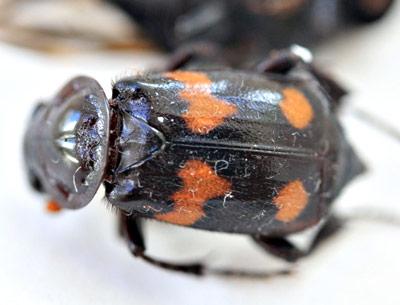Nature Notes: Rare Indeed!

Stuart Vorpahl, an East Hampton Town historian, doesn’t have an office on the town’s campus of historic buildings. His office is in his house on Muir Boulevard in East Hampton. He knows his history, but in a community where the attention is often directed to the situation at hand, history has a very small role to play, if any at all, and thus Stuart is rarely called on to reiterate the local past, which he knows by heart.
Stuart is a jack-of-all-trades, as well. He was a Coast Guardsman, he’s a fisherman, welder, can fix just about anything broken and keep it going, and he is good at raising chickens and ducks. He’s also an ardent observer of nature. More than a month ago, he and a friend were shingling his house, and after work while the sun was setting a strange thing happened. He was checking out two swordfish swords, which were still curing outside the house, when all of a sudden, a large bug flew in low, made a beeline to one of the swords, and landed. Another and another followed suit shortly after the first, and they all began to work over what little gristle or flesh they could find on the sword.
Stuart realized something extraordinary was in progress. He observed the insects carefully. They were some kind of beetle, jet black with four bright markings above, two on each side. But the thing that stirred his curiosity the most was that the antennae were each tipped with a tiny red ball no bigger than a grain of beach sand, but big enough to see in the failing light. He captured two of the three and called me to tell me about the unusual happening.
A little more than a week ago, he brought the critters over for me to take a look at. He arrived with a little transparent plastic dish, some tissue paper folded over inside, a lid tightly sealing the contents.
He folded the paper back and there were these two marvelous beetles. I’ve seen a lot of insects in my 77 years, but nothing like these. I had prepared for his visit by pulling three insect guides from my nature collection, one of which was devoted to beetles. It wasn’t until we opened a guide to California insects that I had picked up at Point Reyes National Seashore about six years ago, that we found what we were looking for. The two curious insects were “burying beetles,” presumably male and female.
I knew enough about burying beetles to know they were considered rare in New York. Various entomologists had told me about their quests for this species here and there and the quests always ended beetle-less. We went directly to the computer, and bingo, there was a nice spread on the species by the State Department of Environmental Conservation. Near the top of the first page were two short phrases in bold red: “New York Status: Extirpated” and “Federal Status: Endangered.” Enough said.
True to form, Stuart sensed that these beetles were remarkably different than all the rest he had run across in his 60-odd years of pursuing this and that, and different they were!
If there were three, there must have been more. If it weren’t for the two swordfish swords curing in the backyard, the American burying beetle would still be considered extinct in New York State. It seems that the red-tipped antennae are adapted for homing in on the odors produced by carrions. That accounts for the straight-line low-trajectory dash to the swords. Flying low and in failing light, they are not likely to be picked out by a predator.
As we read further, we were very much impressed by Stuart’s find. They feed on dead mice and other decaying vertebrates. They lay their eggs on the carcasses after maneuvering them into a hole. How do they do this? They lie on their backs under the carcasses and propel them forward with their feet until they reach their appointed destinations. When the larvae hatch, the adults feed them little pieces of the carcass, in the way that birds feed their nestlings. Quite a cultural advancement for a being as primitive as a beetle, wouldn’t you say?
Are they back? We can’t be sure. What did them in? Pesticides? Diseases? Poisoned rodents? If they are back, and back in East Hampton, it would mean that East Hampton Town has three federally-endangered species (the others being sandplain gerardia and seabeach amaranth). Not every community has someone like Stuart Vorpahl, who would observe this extreme rarity without batting an eyelash. East Hampton is lucky that it does.
Ode to Stuart
Yes, yes,
With his bride by his side
He’s come to reside in
Bonac, a very short ride
to the tide where the creek
opens wide
Finest kind
